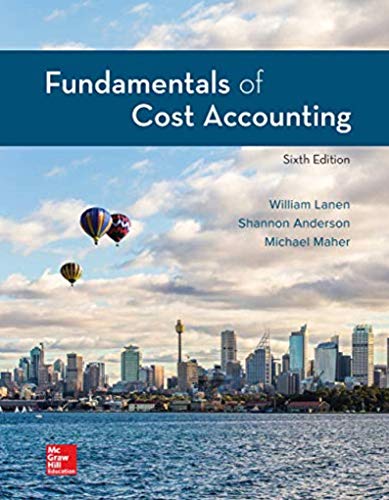
Concept explainers
Find Maximum Input Price: Estimated Net Realizable Value Method
Ticon Corporation’s manufacturing operation produces two joint products. Product delta sells for $24 per unit at the split-off point. After an additional $225,000 of
The joint process has only variable costs. In a typical month, the conversion costs of the joint products amount to $421,000. Materials prices are volatile, and if prices are too high, the company stops production.
Required
Management has asked you to determine the maximum price that the company should pay for the materials.
- a. Calculate the maximum price that Ticon should pay for the materials.
- b. Write a brief memo to management explaining how you arrived at your answer in requirement (a).
Want to see the full answer?
Check out a sample textbook solution
Chapter 11 Solutions
Fundamentals Of Cost Accounting (6th Edition)
- Nonearrow_forwardIf $27,000 was generated from operations, $15,000 was used for investing activities, and $11,000 was provided by financing activities, the cash balance would: help mearrow_forwardA stock is expected to pay a dividend of $2.75 at the end of the year and it should continue to grow at a constant rate of 5% a year. If its required return is 15%, what is the stock’s expected price 3 years from now? Carnes Cosmetics Co.’s stock price is $30, and it recently paid a dividend of $1.00. This dividend is expected to grow by 30% for the next three years, then grow forever at a constant rate of g%. If the company’s required rate of return is 9%, at what constant rate is the stock expected to grow after three years? Foodpanda is expected to pay the following dividends over the next four years: $5, $7, $3.75, and $4.26. Afterwards, the company pledges to maintain a constant 4.25% growth in dividends forever. If the required return on the stock is 9%, what is the current share price? Cardinal Corporation just paid a dividend of $15. However, the management expects to reduce the payout by 2% per year, indefinitely. If you require a return of 10% on this stock, how…arrow_forward
 Cornerstones of Cost Management (Cornerstones Ser...AccountingISBN:9781305970663Author:Don R. Hansen, Maryanne M. MowenPublisher:Cengage Learning
Cornerstones of Cost Management (Cornerstones Ser...AccountingISBN:9781305970663Author:Don R. Hansen, Maryanne M. MowenPublisher:Cengage Learning Managerial AccountingAccountingISBN:9781337912020Author:Carl Warren, Ph.d. Cma William B. TaylerPublisher:South-Western College Pub
Managerial AccountingAccountingISBN:9781337912020Author:Carl Warren, Ph.d. Cma William B. TaylerPublisher:South-Western College Pub Financial And Managerial AccountingAccountingISBN:9781337902663Author:WARREN, Carl S.Publisher:Cengage Learning,
Financial And Managerial AccountingAccountingISBN:9781337902663Author:WARREN, Carl S.Publisher:Cengage Learning,- Principles of Accounting Volume 2AccountingISBN:9781947172609Author:OpenStaxPublisher:OpenStax College
 Managerial Accounting: The Cornerstone of Busines...AccountingISBN:9781337115773Author:Maryanne M. Mowen, Don R. Hansen, Dan L. HeitgerPublisher:Cengage Learning
Managerial Accounting: The Cornerstone of Busines...AccountingISBN:9781337115773Author:Maryanne M. Mowen, Don R. Hansen, Dan L. HeitgerPublisher:Cengage Learning Principles of Cost AccountingAccountingISBN:9781305087408Author:Edward J. Vanderbeck, Maria R. MitchellPublisher:Cengage Learning
Principles of Cost AccountingAccountingISBN:9781305087408Author:Edward J. Vanderbeck, Maria R. MitchellPublisher:Cengage Learning





